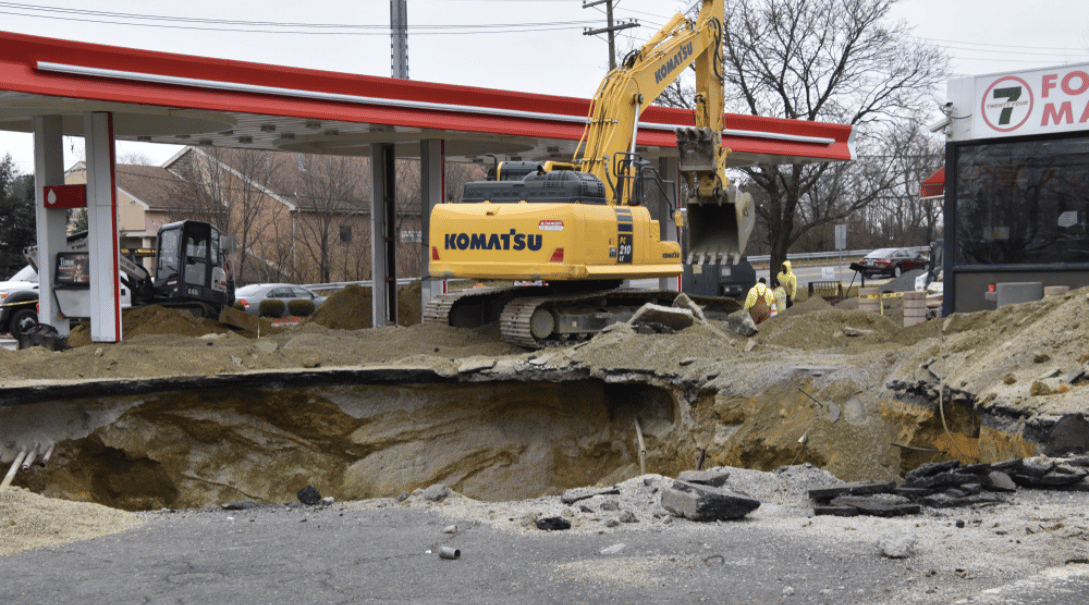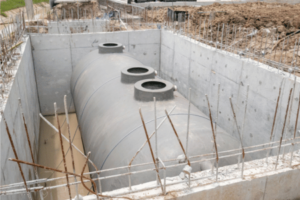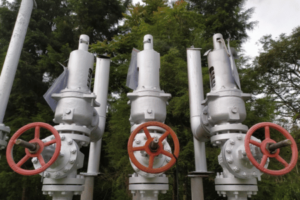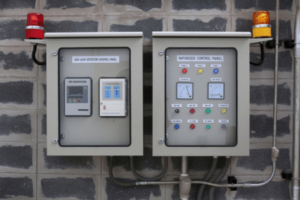Underground storage tanks (USTs) are incredibly useful for storing large quantities of gasses or liquids. However, since they are buried beneath the soil, leaks and other issues with USTs often go undetected. Even a relatively small leak diminishes workplace safety for municipal employees and wreaks havoc on the environment. If the leak and subsequent damage were caused by neglect by your safety and compliance team, you could face stiff penalties, including fines and remediation costs. With that in mind, it’s important to understand the common causes of underground storage tank leaks and the signs that something is awry with your storage system.
The sooner you can detect and remedy a potential leak, the lower the risk to the environment, your staff, and your company.
Table of Contents
The Hidden Dangers: Understanding the Issues Behind Underground Storage Tank Leaks
Underground storage tanks are exposed to different stressors than their above-ground counterparts. However, this does not mean they are impervious to damage, leaks, corrosion, or malfunctions.
Therefore, you must be aware of the common causes of underground storage tank leaks, which are often attributed to one or more of the following factors:
- Corrosion
- Faulty installation
- Poor maintenance
- Aging infrastructure and external forces
- Material incompatibility
- Excessive pressure
- Poor backfill conditions
Many federal, state, and municipal safety regulations are designed to safeguard against these specific causes of UST leaks. However, to truly mitigate the risks of a leak, your organization must first understand how leaks occur to develop an effective leak prevention and detection strategy. Let’s explore the causes mentioned above of leaks in greater detail.
Corrosion: An Invisible Threat
When it comes to underground storage tanks, corrosion is a significant problem. Once corrosion begins, stopping the process and mitigating structural damage to the tank or piping can be incredibly difficult. Preventing corrosion from occurring in the first place is equally difficult, as several factors can cause the metal of your UST to degrade.
The most obvious cause of corrosion is the chemical makeup of the material you store. Corrosion can occur if the stored substance and underground storage tank material are incompatible. Therefore, ensuring your tank is rated to store whatever substance you intend to fill it with is important.
Other corrosion causes include the soil’s pH level around the tank and water. Specifically, you must ensure that water is not in the tank and piping. Even a minuscule amount of water can initiate the corrosion process and compromise the integrity of your tank.
Faulty Installation and Poor Maintenance: A Recipe for Disaster
If you’re preparing to install a new underground storage tank, ensure that your installer has the knowledge and expertise to successfully complete the project. Subpar installation can lead to small leaks in fittings or pipes.
Once these pipes are concreted in place, remedying your leaks will be a costly and time-consuming process. Even worse, the concrete may act as a barrier that temporarily makes the leaks undetectable, which means your UST could contaminate the environment for months before you realize a problem.
Ensuring your underground storage tank is installed correctly is only part of the equation. Once it’s in place, you must follow a stringent maintenance schedule to keep it working as designed. It involves routine inspections of the tank and its components, checking for leaks, and monitoring performance.
External Forces and Aging Infrastructure: Silent Saboteurs
There’s a common misconception that, because they are buried, underground storage tanks are impervious to the effects of external forces. This is simply not the case. While USTs are less susceptible to forces like wind and some types of severe weather, they are not immune to all external factors.
For instance, vehicle traffic, falling trees, or other heavy debris, floods, and construction activities can compromise the function of underground storage tanks. If an overloaded vehicle drives over your UST, a severe weather event occurs, or construction crews work near your tank, you should thoroughly inspect it.
The other silent saboteur that can impact your tank’s integrity is age. Time is undefeated — even the most well-maintained tanks will eventually degrade and subsequently leak. When your UST has reached the end of its viable service life, you must replace it.
Material Incompatibility: When the Stored Becomes the Enemy
All underground storage tanks are created equal, right? Not exactly. USTs are designed from multiple materials for a reason. Pairing an underground storage tank with a material it’s not designed to store can accelerate the degradation process and lead to a leak.
For instance, a fiberglass resin tank is not designed to store ethanol. Filling a fiberglass resin UST with ethanol will compromise the integrity of your USTs fiberglass shell, significantly increasing the risk of a leak or equipment failure.
Before installing a tank, carefully consider what you intend to fill it with. Choose your material based on your intended use case to ensure UST and material compatibility.
Overfilling and Excessive Pressure: The Dangers of More than Enough
Modern underground storage tanks feature several overfill protections designed to keep the volume and pressure in the UST at acceptable thresholds. However, older steel tanks are not equipped with these safety devices. Instead, a tanker truck connects its equipment to a fill pipe. As such, small amounts of product frequently spill onto the ground.
Over time, these little spills can cause a significant volume of potentially harmful substances to disperse into the environment. Additionally, overfilling a UST can place added pressure on its pipes, fitting, and valves, which can shorten the tank’s viable service life and increase the risk of a major leak.
Failure of Pressure Vacuum Relief Valve (PVRV): When Safety Measures Fail
Modern underground storage tanks are equipped with pressure vacuum relief valves (PVRVs) and several other spill and overfill protection devices. These devices significantly improve UST safety and prevent overfilling, excessive pressure, and leaks.
However, PVRVs and all other safety systems must be continuously inspected and repaired when necessary. Many substances can cause the seals on PVRVs to dry and crack, resulting in failure. A well-designed maintenance schedule will help you identify signs of a seal or gasket so you can proactively replace these components.
Poor Backfill Condition: The Role of the Supporting Cast
Backfilling is the process of filling in the area around your underground storage tank to provide stability, support, and protection. Choosing the right backfill materials will add strength, moisture regulation, and permeability, reducing the leak risk.
However, if the backfill process is not performed correctly or if the wrong materials are used, the integrity of your tank will be compromised. Under the worst of circumstances, poor backfill conditions can make your concrete sink, which could damage pipes and the tank itself.
How Do You Know if an Underground Storage Tank Is Leaking?
Familiarizing yourself with the common causes of underground storage tank leaks will go a long way toward helping you prevent spills and other equipment failures. However, even the most well-designed strategies are not 100% full-proof, so you must also know the signs of trouble.
Due to the complexity of underground storage tank systems and the large degree of variability in terms of design and installation, leaks can manifest in several ways. Let’s examine the physical signs, environmental indicators, and the importance of inspections and monitoring systems in leak detection.
Physical Signs of a Leak
Physical signs of an underground storage tank leak can range from obvious to mildly noticeable, depending on the severity of the malfunction. If your leak is relatively minor, your staff may observe physical indicators such as erratic equipment behavior or reduced dispensing speed. Other physical signs of a leak include visible dripping from pipe joints or fittings.
If your underground storage tank experiences a major failure, the physical signs of a leak can include pooling above your tank or pipes, complete equipment failure, or a total loss of pressure at dispensing systems.
Environmental Indicators
Several environmental indicators will manifest during a prolonged or severe leak. One major indicator of a leak is complaints of changes in water taste or smell. If residents near your facility begin to report these changes or detect the smell of petroleum vapors in their basements, you need to contact an emergency spill response team right away.
Another major warning sign that you have a leak is if your stored product is visible on water near your facility. This means that your underground storage tank is not only leaking, but the spill is also seeping into nearby waterways. The costs of remediation damage to water systems can be severe, so you need to act fast.
Monitoring Systems and Inspections
If you have detected any physical or environmental signs of an underground storage tank leak, there is a good chance you will incur some remediation expenses. Depending on the severity of the leak, you may also be subject to federal, state, and municipal fines.
Therefore, it’s vital that you proactively work to prevent and detect leaks before they negatively impact the surrounding environment. To do that, you will need to use a combination of physical inspections and leak detection monitoring technology.
During a physical inspection, one of your team members or a third-party inspection firm will examine the components of your underground storage tank system. They will note any concerns, report back to you, and make repair recommendations if necessary.
The leak monitoring system continuously tracks tank pressure, volume, and other variables to identify discrepancies in UST performance. For instance, if your tank experiences a sudden drop in pressure and begins losing volume, you probably have a leak.
Leak monitoring technology gives you a headstart in the event of a leak. As a result, you can contact a spill response team and mitigate damage to the environment.
Navigating the Challenges of Underground Storage Leaks
Now that you have familiarized yourself with the common causes of underground storage tank leaks, you will be better prepared to identify and prevent them. However, managing underground storage tanks and navigating the municipal safety regulations governing their use can still be complex.
Therefore, consider partnering with a third-party inspection service provider, Alpha-Omega Training and Compliance (AOTC). In addition to providing tank inspection services, we also offer a wide range of other training and support, including on-site municipal safety training courses, remediation, and 24/7 emergency spill response.
Do you want to optimize workplace safety for municipal employees and partner with a team that understands the underground storage tank compliance landscape? If so, connect with AOTC.



